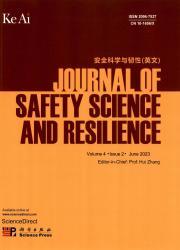公寓居民的地震管理知识与实践:以印尼雅加达市为例
IF 3.4
Q1 PUBLIC, ENVIRONMENTAL & OCCUPATIONAL HEALTH
引用次数: 0
摘要
城市公寓和公寓居民面临着越来越多的地震威胁,目前高层住宅社区对地震风险降低技术的理解和实施仍然缺乏。因此,本研究考察了地震管理实践与人口特征、垂直房屋特征、地震管理知识和应急响应计划之间的关系。该研究采用了横断面研究设计,包括来自14个选定公寓的215名参与者。结果表明:(1)35 ~ 54岁、住宅单元类型、住宅面积、房间数、居住年限3 ~ 5年、应急预案、地震管理知识(地震前、地震中、地震后)等方面的地震管理实践存在差异;(2)地震管理知识水平(包括地震减灾和自救知识)较低;(3)应急响应和地震管理实践不足;(4)具有中等地震自救知识水平的公寓居民具有中等地震自救知识水平的可能性是无地震自救知识水平的公寓居民的12.2倍(OR = 12.2, p = 0.000)。该研究建议国家灾害管理局和雅加达市减少灾害风险论坛与建筑物管理人员合作,制定一个年度地震减灾方案,以提高有关减少地震风险的知识水平。本文章由计算机程序翻译,如有差异,请以英文原文为准。
Knowledge and practice of earthquake management among apartment dwellers: A case study of Jakarta City, Indonesia
Urban city apartments and flat dwellers face increasing threats from earthquakes, and the current understanding and implementation of earthquake risk reduction techniques in high-rise housing communities remain lacking. Therefore, this study examined the relationships between earthquake management practices and demographic characteristics, vertical housing features, earthquake management knowledge, and emergency response plans. The research employed a cross-sectional study design and included 215 participants from 14 selected apartments. The findings indicated that (1) earthquake management practices vary among individuals aged 35–54, types of dwelling units, dwelling sizes, numbers of rooms, those who have resided in an apartment for 3–5 years, emergency response plans, and knowledge regarding earthquake management (before, during, and after); (2) earthquake management knowledge levels (including mitigation and self-rescue knowledge during an earthquake) are low; (3) emergency response and earthquake management practices are insufficient; and (4) apartment dwellers with moderate knowledge levels of earthquake self-rescue are 12.2 times more likely to have moderate earthquake management practices than those without (OR = 12.2, p = 0.000). The study recommends that the National Disaster Management Authority and the Jakarta City Disaster Risk Reduction Forum collaborate with building managers to develop an annual earthquake mitigation programme to enhance knowledge levels regarding earthquake risk reduction.
求助全文
通过发布文献求助,成功后即可免费获取论文全文。
去求助
来源期刊

安全科学与韧性(英文)
Management Science and Operations Research, Safety, Risk, Reliability and Quality, Safety Research
CiteScore
8.70
自引率
0.00%
发文量
0
审稿时长
72 days
 求助内容:
求助内容: 应助结果提醒方式:
应助结果提醒方式:


